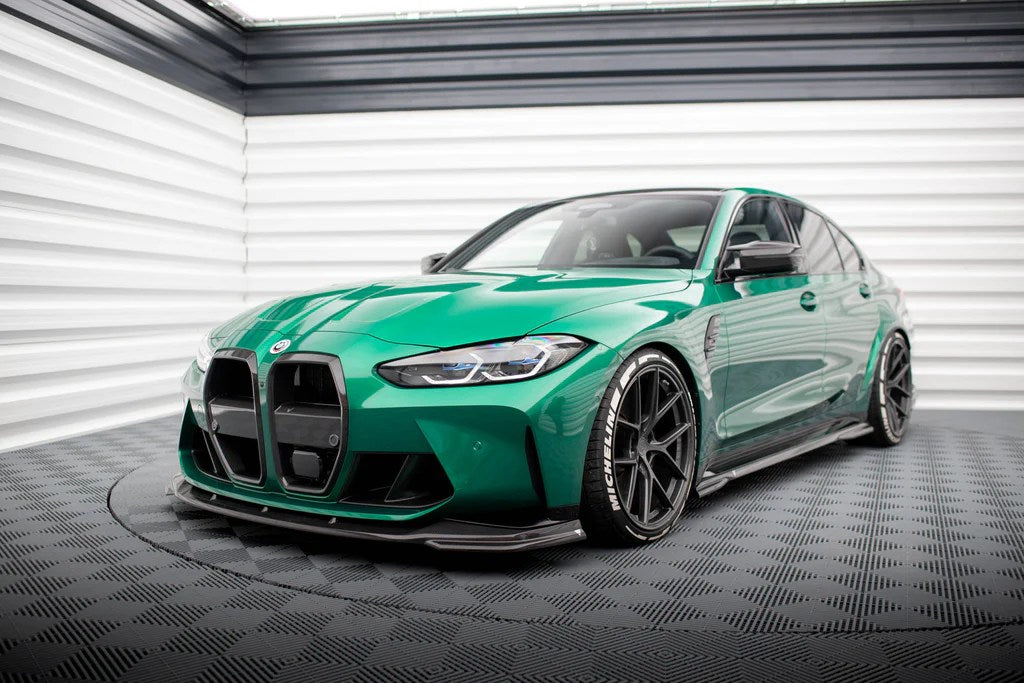Have you ever spotted a car with a sleek body kit and thought, "That looks sharp!"? Well, there's more to these kits than meets the eye.
Beyond aesthetics, body kits play a significant role in how a car handles the air around it, much like how an aerodynamic bike helmet can improve the aerodynamics and speed of a time-trial cyclist.
In this article, we'll break down the real-world connection between body kits and aerodynamics, showing that most body kits aren't just about style. Sometimes, they're also about performance.
Aerodynamics
Aerodynamics is the science of how air interacts with moving objects, such as cars. In the automotive world, it's all about how air affects a vehicle's efficiency and stability.
When a car moves, it faces resistance from the air, called drag. Minimising this drag can boost fuel efficiency and increase top speed. However, it's not just about cutting through the air; cars also need downforce, which is the force pushing them down onto the road. It ensures the tires maintain good grip, especially at high speeds, enhancing handling and safety.
A car's design itself also manages airflow to cool essential components like the engine or brakes, using features like vents and scoops.
As air moves over and around a car, it creates turbulent areas or different pressure zones. By understanding and manipulating these, one can make a car not only faster but also more stable and efficient.
Now you know a lot about aerodynamics, let’s now find out if body kits really improve your car’s aerodynamics.

The truth about body kits and aerodynamics
Generally, body kits can be divided into two categories: functional and cosmetic.
High-quality and functional body kits are designed with performance in mind and have often undergone wind tunnel testing to enhance a car's aerodynamics. These kits can reduce drag, increase downforce, or optimize airflow for better cooling.
On the other hand, many body kits on the market prioritize aesthetics over performance. While they may give the car a sportier or more aggressive look, they might not offer any real aerodynamic advantage, and in some cases, can even hinder it.
When considering aerodynamic modifications, it's essential to focus on the overall balance of the vehicle. Adding isolated components like a front splitter or a large rear wing without considering their impact on the car's total aerodynamic profile can lead to imbalances.
For instance, while some modifications can increase downforce aiding in high-speed cornering, they might also ramp up drag, compromising straight-line speed. For genuine aerodynamic gains, it's vital to choose kits and components with a proven track record of performance improvements.

Body kit components that make your car more aero
If you’re planning to customise your car and make it more aerodynamic, below are the body kit components you must have on your checklist:
Front Splitter
A front splitter is a horizontal lip attached to the front-end of a car, usually protruding outwards. Its primary job is to redirect the oncoming air around the sides of the vehicle and to the undercarriage.
By doing so, it prevents air from getting underneath the car, which can cause lift. Simultaneously, a splitter can generate downforce on the front axle, improving front-end grip and stability, especially during high-speed cornering.
Check out our front lips and splitters.
Rear Diffuser
Located at the rear underbody of a car, a rear diffuser consists of a series of channels and fins. Its design accelerates the air passing beneath the car and aids in its smooth reintegration with the slower-moving ambient air.
This process reduces the turbulent low-pressure area behind the car, thereby decreasing drag. Additionally, the diffuser can help generate rear-end downforce, ensuring the rear tires maintain better contact with the road.

Rear Wing/Spoiler
While often used interchangeably, wings and spoilers serve different purposes. A wing stands off the car's surface and produces downforce by creating a high-pressure zone on top and a low-pressure zone beneath.
This downforce improves rear-end stability and grip. On the other hand, a spoiler is designed to "spoil" or disrupt undesirable air movement across the body of the car, reducing lift and drag. Its primary function is to help maintain the car's balance by managing airflow, rather than generating significant downforce like a wing.

Side Skirts
Running between the front and rear wheel arches, side skirts act as barriers that prevent high-speed air from entering the undercarriage. This action helps in reducing turbulence and possible lift caused by air rushing beneath the car. The smoother side profile created by side skirts can lead to decreased drag and enhanced high-speed stability.
Hood Vents
While their primary purpose is often cooling-related, hood vents play a role in aerodynamics too. By allowing high-pressure air from the engine bay to escape, they can reduce front-end lift, contributing to better stability and handling, especially at elevated speeds.
Canards or Dive Planes
Attached to the front bumper or fenders, canards are wing-like projections that produce vortexes, helping to direct airflow around the car's sides. They can also generate a bit of additional downforce on the front end. By influencing the direction of oncoming air and the pressure differentials around the car, canards can enhance both grip and stability.

Conclusion
There’s no doubt that body kits can enhance a car's aerodynamics, leading to better speed, fuel efficiency, and handling. If you're aiming for better performance, especially at high speeds, it's worth considering.
When integrating these components, it's important to consider the car's overall aerodynamic balance. A car that's aerodynamically balanced will handle predictably, while a car with too much front or rear downforce can become difficult to control, especially at high speeds. It's always a matter of understanding the entire aerodynamic picture, not just individual parts.
When in doubt, you can always have a chat with us regarding your custom car project. We’ll help you choose what body kits are best suited for your ride.






